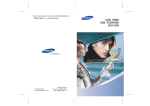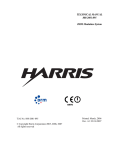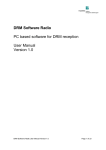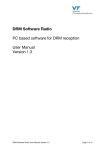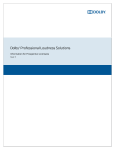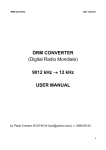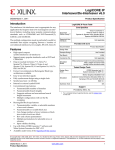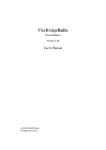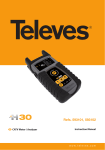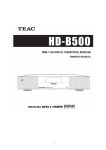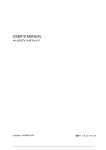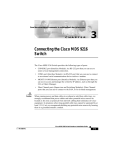Download Digital World Traveller - Coding Technologies | welcome to the
Transcript
Digital World Traveller Radio receiver for Digital Radio Mondiale, AM and FM broadcasts Overview Dear customer, Thank you for purchasing a Digital World Traveller! The Digital World Traveller is a small, universal and easy to use mobile radio receiver for reception of Digital Radio Mondiale (DRM) broadcasts, the new standard for digital broadcasting below 30 MHz. It also supports analogue broadcasts in the FM and AM bands. The Digital World Traveller consists of a receiver box, which is connected to a Notebook/PC over USB, and a software to control the receiver box and to perform the decoding of the DRM broadcasts. The software controls all functions of the Digital World Traveller and allows the storage of up to 8 stations for each frequency band. In the DRM mode, the software indicates the available service components and text messages of a DRM broadcast. An expert mode window provides additional information about the service components and also displays the spectrum of the received signal. By attaching the CE symbol to the product, the manufacturer is confirming that its product conforms to the requirements corresponding with the EU guidelines applicable for the product, in particular, that all safety requirements have been met. In addition, the observance of the applicable standards is documented in the form of a written CE conformity declaration. Digital World Traveller User’s Guide as of software version 1.0.12 The receiver box is powered over the USB interface, so no external power supply is required. 1 © Copyright by Coding Technologies GmbH What is Digital Radio Mondiale? Digital Radio Mondiale (DRM) is the brand new, highly innovative system standard for digital broadcasting in short-wave, medium-wave and longwave. Besides providing near-FM quality audio, the DRM system has the capacity to integrate data and text. Unlike digital systems that require a new frequency allocation, DRM uses existing AM broadcast frequency bands. The DRM signal is designed to fit in with the existing AM broadcast band plan, based on signals of 9 kHz or 10 kHz bandwidth. Included in delivery Your Digital World Traveller includes: - The Digital World Traveller receiver box - USB cable - Wire antenna - Installation CD with the Digital World Traveller software radio and the user manual (this document) Connections Limited bandwidth and the critical transmission conditions of the AM channels place highest demand on an appropriate audio codec. The selection of aacPlus for the new DRM digital broadcasting system demonstrates impressively the benefits of combining high coding efficiency with error robustness for transmission over difficult channels. Thus, DRM incorporates aacPlus as the ideal solution for maximum coding efficiency. 1 1 2 3 4 5 Digital World Traveller User’s Guide as of software version 1.0.12 2 2 3 4 5 Headphones USB Control LED Wire Antenna Loop Antenna © Copyright by Coding Technologies GmbH Getting Started with Digital World Traveller PC Software Installation Important: Administrator privileges are required to install the software package! Please complete the following steps before attaching your Digital World Traveller to the PC: - Insert the installation CD into the optical disc drive. If you have a previously installed version of the Digital World Traveller software on your system and have downloaded a new version from Coding Technologies’ web site, please proceed exactly as described below. You do not need to uninstall any previous versions of the software. - Execute the Setup_DigitalWorldTraveller_1.0.12.exe from the installation CD or from your download directory. The following screen will appear: - Click "Next”. - The Version Information screen displays a list of components to be installed. - Click “Next”. - The End User License Agreement screen will appear. - Please read the license terms before installing the Digital World Traveller software. - Accept the terms in the licensing agreement by checking the box. - Click "Next”. - In the next screen, choose an install location. Default is c:\program files\DigitalWorldTraveller (recommended). - Digital World Traveller User’s Guide as of software version 1.0.12 3 © Copyright by Coding Technologies GmbH - Click "Next”. - In the next screen, select the Start Menu's Folder in which you would like to create the program’s shortcuts. Default is “Digital World Traveller” (recommended). - Click "Next”. - The next screen prompts you to install the USB device driver for your Digital World Traveller. - - Click “Yes”. - The next screen prompts you to plug your Digital World Traveller in the USB port. - Plug the Digital World Traveller into the USB port of your PC, wait until Windows driver are loaded and click “OK”. The USB device driver will be installed. - When the USB device driver installation is completed, click “Close”. - Click “Finish” to complete the PC software installation. You have now successfully installed your Digital World Traveller software radio. Digital World Traveller User’s Guide as of software version 1.0.12 4 © Copyright by Coding Technologies GmbH Usage of Digital World Traveller Important: before starting the Digital World Traveller Software radio, plug the Digital World Traveller receiver to the USB port of your PC. The Digital World Traveller Main Screen 1 3 2 4 5 6 1 2 3 4 5 6 7 8 9 10 11 12 13 14 15 16 17 18 19 20 20 19 7 18 17 8 16 15 14 9 13 12 Digital World Traveller User’s Guide as of software version 1.0.12 11 Reception mode selector Stereo/Mono indicator Radio frequency display Radio frequency search Setup button About button Station indicators Station memory buttons Clock (Local/UTC) Volume control slider Mute button DRM expert mode switch DRM text message box DRM synchronization indicator DRM service description indicator DRM audio service indicator DRM service component indicator Stereo/Mono switch DX/Local attenuator control switch RF level indicator 10 5 © Copyright by Coding Technologies GmbH The Digital World Traveller DRM Expert Screen 21 23 21 22 23 24 22 24 DRM RF/IF spectrum display DRM service information box DRM RF level indicator DRM IF level indicator Digital World Traveller User’s Guide as of software version 1.0.12 6 © Copyright by Coding Technologies GmbH 1 Reception mode buttons The reception mode buttons allow switching between digital DRM reception and analog FM/AM reception. Additionally, the DRM button selector provides access to four separate levels of the station memory buttons (see “8 station memory buttons”), allowing you to store 32 DRM channels total. The respective level is indicated by up to four orange LEDs inside the button, one LED for level 1, and four LEDs for level 4. Toggle through the separate levels by repeatedly clicking on the DRM reception mode button. Choose e.g. USB audio device/Digital World Traveller in the output option to determine whether the Digital World Traveller audio output or the build-in audio sound card is used for playback. Choose Wire or Loop antenna according to the antenna type you are using. Choose Wire for the antenna included in your package. 2 Stereo/Mono indicator The stereo/mono indicator displays the channel configuration of the received radio program. 3 Radio frequency display The frequency display is a multifunctional field, allowing to quickly enter a frequency numerically. - - Double-click highlights all frequency digits. To enter a new one, simply type the new frequency and press “Enter”. Single-click activates the cursor. Change single digits and press “Enter”. 4 Radio frequency search The radio frequency search allows automatically scanning of the spectrum in the FM reception mode upwards and downwards. In DRM and AM reception mode, it allows to step in 1 kHz steps through the spectrum. 5 Setup button The setup allows specifying input and output device and type of antenna in use. Digital World Traveller User’s Guide as of software version 1.0.12 6 About button The about button displays company information and a link to the DRM live broadcast schedule in the Internet. 7 Station indicators The station indicators display the station the Digital World Traveller is currently tuned to. 8 Station memory buttons The station memory buttons are multifunctional buttons, allowing to quickly access a formerly saved radio station. - 7 Tune into a certain station. © Copyright by Coding Technologies GmbH - Right-click a station memory button you want to save the station to. A window will pop-up: 12 DRM expert mode switch This switch allows switching the expert screen on and off. 13 DRM text message box This box displays text messages that are transmitted along with the currently received service. 14 DRM synchronization indicator This indicator highlights as soon as the Digital World Traveller software synchronizes to a DRM broadcast signal. 15 DRM service description indicator - For DRM reception, the program name will automatically be included. - Edit the label if required. - Press “Store”. The station has now been stored to the respective station memory button. 9 Clock local/UTC The clock automatically displays Universal Time Coordinate (UTC) depending on the system clock. 10 Volume control slider Use the volume control slider to increase or decrease the audio output volume. 11 Mute button This indicator highlights as soon as the Digital World Traveller software has decoded the information contained in the service description channel (SDC). After decoding the SDC, the Digital World Traveller has all information necessary to begin decoding of the DRM program. 16 DRM audio indicator This indicator highlights as soon as the Digital World Traveller software decodes audio information contained in a DRM broadcast signal. 17 DRM service component indicator Each DRM program may contain up to four service components. These service components can contain audio, text, or multimedia information. The DRM service component indicator field lists the service components included in a DRM broadcast. Use the mute button to mute the audio output. Digital World Traveller User’s Guide as of software version 1.0.12 8 © Copyright by Coding Technologies GmbH 18 Stereo/Mono switch This switch allows switching a stereo program to mono playback. 19 DX/local attenuator control switch This switch allows attenuating strong broadcast signals in order to avoid overmodulation. Try this switch to increase reception quality either for long distance or local broadcasts. 20 RF level indicator This indicator displays the strength of the received broadcast signal. 21 DRM RF spectrum display This display shows the currently received DRM signal. The waveform of the signal (green) should be stable recognizable clear, without too much of fading. The Signal-to-Noise Ratio (SNR) in the upper right corner of the display should not be lower than 13 dB to ensure proper DRM decoding. DRM AM FM RF IF UTC DX SNR USB PC LED SDC Digital Radio Mondiale Amplitude Modulation Frequency Modulation Radio Frequency Intermediate Frequency Universal Time Coordinate Long distance reception Signal-to-Noise Ratio Universal Serial Bus Personal Computer Light Emitting Diode Service Description Channel Caring for your Digital World Traveller Maintenance Advice 22 DRM service component information box This box displays additional information of the respective service component, e.g. bit rate of the audio bit stream or text information, the codec in use, or the service language. 23 DRM RF level indicator • Do not use your Digital World Traveller at temperatures below 0° C or above 50° C. • Protect your Digital World Traveller from moisture and dust. • Do not open your Digital World Traveller housing. This will invalid the warranty. This indicator displays the strength of the received DRM broadcast signal. 24 DRM IF level indicator This indicator displays the strength of the intermediate frequency of the received DRM signal. Digital World Traveller User’s Guide as of software version 1.0.12 9 © Copyright by Coding Technologies GmbH Trouble Shooting General note: the reception quality of radio broadcasts below 30 MHz, especially short-wave reception, depends on several factors like time of the day, weather conditions, electromagnetic pollution etc. This holds true for analog, but certainly also for digital broadcasting. For digital reception, the Signal-to-Noise Ratio (SNR) is being displayed in the expert screen (press the expert mode button in the main screen of the Digital World Traveller software radio). The SNR should be at least 13 dB. C:\Documents and Settings\<your user name>\My Documents\Digital World Traveller\ and replace the stations.cfg file to be found here. Q: During installation, I get a plug-and-play-error after connecting the Digital World Traveller to my PC. What can I do? A: Please restart your computer and repeat the installation process as described above. The problem should not occur a second time. If it does, disconnect the Digital World Traveller, exit the Digital World Traveller software radio, and run the installation program again. Q: I installed and already successfully used my Digital World Traveller, however at next start-up it won’t work. A: Please change the USB port on your computer to the one you used during installation. Windows assigns USB drivers to the respective USB ports separately. Q: After installing a new version of the Digital World Traveller software radio, my previously stored stations are not available anymore! Did they got lost? A: No. The Digital World Traveller software radio stores the stations in a file named “stations.cfg”. From version 1.0.0.12, the software is capable of storing the stations for every single user of your system. If you do not find your previously stored stations, copy your old stations.cfg file located in C:\Program Files\DigitalWorldTraveller\ into the new directory which is Digital World Traveller User’s Guide as of software version 1.0.12 10 © Copyright by Coding Technologies GmbH Technical Specifications Supported DRM Modes The DRM Receiver currently supports the following DRM modes: Antenna jack pin assignments Wire antenna jack: Channel coding and modulation: All channel coding and modulation modes specified in the DRM specification, including: Live on tip - All code rates EEP and UEP Standard and Hierarchical modulation (SM, HMSym and HMMix) Both MSC constellations (64QAM and 16QAM) Both SDC constellations (16QAM and 4QAM) Long and short cell interleavers Transmission structure: All robustness modes (A, B, C and D) Spectral occupancies (4.5, 5, 9, 10 kHz) Loop antenna jack Source Coding aacPlus (AAC+SBR) mono, parametric stereo, stereo, HVXC and CELP speech coding and SBR for speech coders Interfaces - Antenna input for loop and wire antennas (switchable by software) - Headphones output - USB interface for connection to PC Digital World Traveller User’s Guide as of software version 1.0.12 Ground 11 Live on tip © Copyright by Coding Technologies GmbH Dimensions L x W x H: 11 cm x 6 cm x 3 cm Weight: 110 g (receiver box only) System requirements - Windows 2000, Windows XP Home Edition and Professional - P III or equivalent, clock rate at least 500 MHz - ~25 MB free hard disk space Contact: Coding Technologies GmbH Deutschherrnstrasse 15-19 90429 Nürnberg Germany www.codingtechnolgies.com [email protected] [email protected] Copyright note: Coding Technologies, aacPlus, and Digital World Traveller are registered trademarks. For copying this manual, even by extract, an explicit written permission of Coding Technologies GmbH is required. Digital World Traveller User’s Guide as of software version 1.0.12 12 © Copyright by Coding Technologies GmbH












